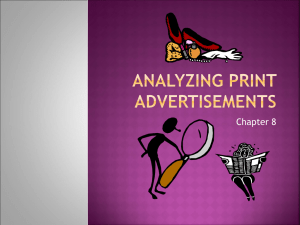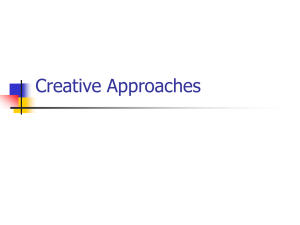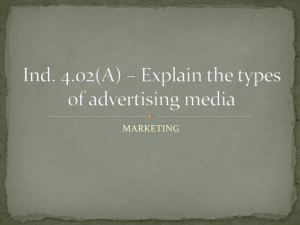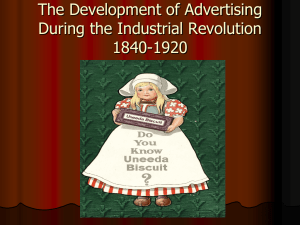Linear Programming: Introduction & Examples
advertisement
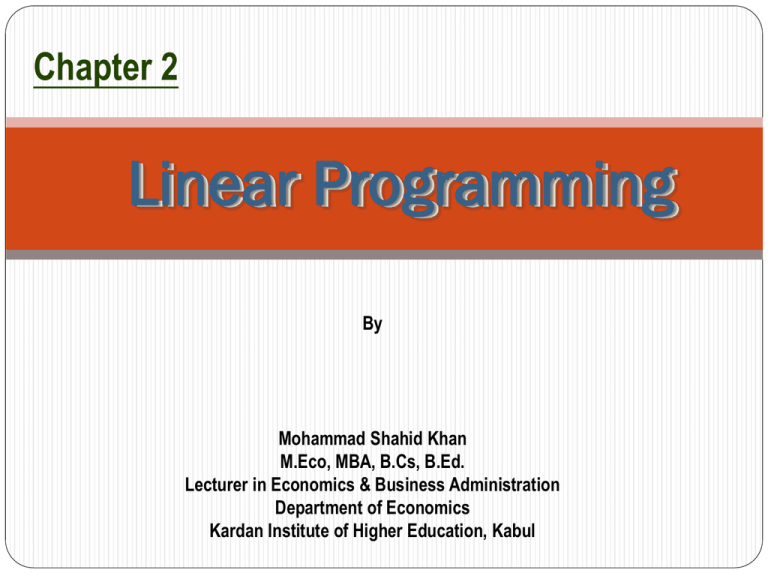
Chapter 2 Linear Programming By 1 Mohammad Shahid Khan M.Eco, MBA, B.Cs, B.Ed. Lecturer in Economics & Business Administration Department of Economics Kardan Institute of Higher Education, Kabul Introduction to Linear Programming: Linear Programming is a mathematical technique that seeks to maximize or minimize a linear function, subject to a set of linear constraints. Linear programming is a mathematical technique designed to aid managers in allocating scarce resources (such as labor, capital, or energy) among competing activities. It reflects, in the form of a model, the organization‘s attempt to achieve some objective (frequently, maximizing profit contribution, maximizing rate of return, minimizing cots) in view of limited or constrained resources (available capital or labor, service levels, available machine time, budgets). 2 Introduction to Linear Programming: The linear model consists of the following components: A set of decision variables. An objective function. A set of constraints. Min C=3x + 4y Subject to 3 5x + 8y 24 , x0, y0 Terminology: Decision variables: e.g., x and y. In general, there are quantities you can control to improve your objective which should completely describe the set of decisions to be made. Objective Function. The Objective Function is a linear function of variables which is to be optimized i.e., maximized or minimized. e.g., profit function, cost function etc. The objective function may be expressed as a linear expression. e.g., Min C=3x + 4y Constraints: e.g., 5x + 8y 24 , x 0 , y 0 4 Limitations on the values of the decision variables. Feasible Solution: A set of values of the variables x1, x2, x3,….,xn which satisfy all the constraints is called the feasible solution of the LPP. Optimal Solution. A feasible solution that makes the value of the objective function an optimum (maximum or minimum) is called an optimal solution. Steps in Linear Programming: 1. Identifying the problem: The first step in Linear Programming is to identify the problem and it causes. problem may be vague, find appropriate objective of the problem. Identify the decision variables and assign symbols x and y to them. These decision variables are those quantities whose values we wish to determine. Identify the set of constraints and express them as linear equations in terms of the decision variables. These constraints are the given conditions. Steps in Linear Programming: 2. Construct a (math) model and data acquisition. Find model appropriate for objective. Identify the objective function and express it as a linear function of decision variables. It might take the form of maximizing profit or production or minimizing cost. 3. Deriving a solution (optimal or good enough solution) using the substitution or graphical or simultaneous equation methods to solve the constraints equations to find the feasible solutions for the decision variables of the model. Steps in Linear Programming: 4. Test the model and the solution: check the function value for the various feasible solutions and find the optimum value which satisfies the objective of the function. 5. Implementation of the solution: The last step is to practically implement the solution to the problem for which the model was constructed and optimal value of the decision variable is derived. Advantages of Linear Programming i. The linear programming technique helps to make the best possible use of available productive resources (such as time, labour, machines etc.) Limitations of Linear Programming (a). Linear programming is applicable only to problems where the constraints and objective function are linear i.e., where they can be expressed as equations which represent straight lines. In real life situations, when constraints or objective functions are not linear, this technique cannot be used. (b). Factors such as uncertainty, weather conditions etc. are not taken into consideration. Graphical Analysis of Linear Programming In the graphical technique, each inequality constraint is graphed as an equality constraint. The Feasible Region is determined from the points where constraints intersect each other. The Feasible Solution Space is the area which satisfies all of the inequality constraints. The Optimal Feasible Solution occurs along the boundary of the Feasible Solution Space, at the extreme points or corner points. Note: The feasible region will be Left to the Feasible Region Curve when constraints include < sign The Feasible region will be Right to the Feasible Region Curve if the constraints include > sign 10 GRAPHICAL Corner Points A, B, and C X2 A Feasible Region OABC O B C X1 GRAPHICAL Corner Points A, B, and C X2 A B Feasible Region OABC O C X1 Example: Graphical Solution Consider the product mix problem Maximize 5 x1 4 x2 subject to 3x1 2 x2 60 1x1 2 x2 40 x1 0, x2 0 We obtain x1 * 10, x2 * 15. The optimal value of the objective function is VOF ( x*) 5(10) 4(15) 110. Graphical Solution: Practice to Formulate the Objective Function and Constraints Example 1: Product Mix The Regal China Company produces two products daily plates and mugs. The company has limited amounts of two resources used in the production of these products clay and labor. Given these limited resources, the company desires to know how many plates and Mugs to produce each day, in order to Maximize profit. The two products have the following resource requirements for production and profit per item produced (i.e., the model parameters). Product Plate Mug Labor (hours/unit) 1 2 Clay (lbs./unit) 4 3 Profit (Rs./unit) 4 5 There are 40 hours of labour and 120 pounds of clay available each day for production. The objective of the company is to Maximize total profit. The company's profit is the sum of the individual profits gained from each plate and mug. As such, profits from plates is determine by multiplying the unit profit for each plate, 4, by the number of plates produced, X1. Likewise, profit derived from mugs is the unit profit of a mug, 5, multiplied by the number of mugs produced, X2. Thus, total profit, Z, can be expressed mathematically as Maximize Z = 4X1 + 5X2 where Z = total profit per day 4X1 = profit from plates ; 5X2 = profit from mugs By placing the term Maximize in front of the profit function, the relationship expresses the objective of the firm to Maximize total profit. Model Constraints This problem has two resources used for production, which are limited, labor and clay. Production of plates and mugs require both labor and clay. For each plate produce, one hour of labor is required. Therefore, the labor used for the production of plates is 1X1 hours. Similarly, each mug requires two hours of labor; the labor used for the production of mugs is 2X2 hours. Thus, the labor used by the company is the sum of the individual amounts of labor used for each product. 1X1 + 2X2 However, the amount of labor represented "1X1 + 2X2" is limited to 40 hrs per day, thus, the complete labor constraint is 1X1 + 2X2 < 40 hours Constraints……. continued The constraint for clay is formulated in the same way as the labor constraint. Since each plate requires four pounds of clay, the amount of clay used daily for the production of plates is 4X1 pounds, and since each mug requires three pounds of clay, the amount of clay used for mugs daily is 3X2. Given that amount of clay available for production each day is 120 pounds, the material constraint can be formulated as 4X1 + 3X2 < 120 pounds A final restriction is that the number of plates and mugs produced be either zero or a positive value, since it would be impossible to produce negative items. These restrictions are referred to as nonnegative constraints and are expressed mathematically as X1 > 0, X2 > 0 The complete linear programming model for this problem can now be summarized as Maximize Z = 4X1 + 5X2 Subject to 1X1 + 2X2 < 40 4X1 + 3X2 < 120 X1, X2 > 0 Example. A Product Mix Problem A firm produces two different products P1 and P2. Every unit of P1 uses 3 units of resource(R1) and 1 unit of resource(R2) and earns a profit of 5 Afs. Similarly every unit of P2 uses 2 units of resources (R1) and 2 units of resource (R2) and earns a profit of 4 Afs. Resources R1 and R2 are available in quantities as 60, 40 respectively. The firm wants to determine how many of the two products must be manufactured each week in order to maximize profit subject to resource availability. Product Mix Problem…continued A firm produces two different products P1 and P2. Every unit of P1 uses 3 units of resource(R1) and 1 unit of resource(R2) and earns a profit of 5 Afs. Similarly every unit of P2 uses 2 units of resources (R1) and 2 units of resource (R2) and earns a profit of 4 Afs. Resources R1 and R2 are available in quantities as 60, 40 respectively. The firm wants to determine how many of the two products must be manufactured each week in order to maximize profit subject to resource availability. Product Mix Problem….. continued R1 R2 Unit Profit Product1 P1 (per unit) Product2 P2 (per unit) Available Resource 3 1 5 2 2 4 60 40 Let xi (i 1,2) represent the weekly production of Pi . Profit P is given by P 5 x1 4 x2 . The available resources constrain the values of x1 and x2 , i.e., 3x1 2 x2 60 1x1 2 x2 40 60 Since xi is output, then x1 0 and x2 0. The problem is formally stated as follows: Maximize 5 x1 4 x2 subject to 3x1 2 x2 60 1x1 2 x2 40 x1 0, x2 0 Example. A Nutrition Aid Problem A Nutrition Aid Program is considering two food supplements S1 and S2 for distribution among a population deficient in nutrients N1, N2, and N3. Each unit of S1 provides 4 units of N1, 8 units of N2, 5 units of N3, and costs $6. Similarly each unit of S2 provides 12 units of N1, 4 units of N2, 5 units of N3, and costs $4. The minimum daily requirement per person of N1, N2, N3 are 96, 112 and 100 respectively. The problem is to determine the daily quantities of the food supplements for each person that meet the minimum daily requirements and entail the least cost. Table 3.1. Dietary and Price Data S1 (Per Unit) S2 (Per Unit) N1 4 12 Minimum Daily Requirement (Per Person) 96 N2 8 4 112 N3 5 5 100 Price 6 4 To formulate this problem mathematically, let x i (i = 1,2) denote the quantity of Si (i = 1,2) needed per person per day. The cost C (assuming no discounts) is given by C = 6x1 + 4x 2 . To satisfy the.minimum.daily requirements, we must have 4x1 + 12x 2 > 96 8x1 + 4x 2 > 112 5x1 + 5x 2 > 100. Finally, the quantities x i must not be negative, i.e., x1 >0, x 2 0. The problem is expressed formally as follows: Minimize 6x1 + 4x 2 subject to 4x1 + 12x 2 > 96 8x1 + 4x 2 > 112 5x1 + 5x 2 > 100 and x1 >0, x 2 0. Example 5 Marketing The Bata Shoe Company has contracted with an advertising firm to determine the types and amount of advertising it should have for its stores. The three types of advertising available are radio and television commercials and newspaper ads. The retail store desires to know the number of each type of advertisement it should purchase in order to Maximize exposure. It is estimated that each ad and commercial will reach the following potential audience and cost the following amount. Type of Advertisement Exposure (people/ad or commercial) Cost Television commercial 20, 000 Rs. 15, 000 Radio commercial 12, 000 8, 000 Newspaper ad 9, 000 4, 000 The following resource constraints exist: 1. There is a budget limit of Rs. 100,000 available for advertising. 2. The television station has enough time available for four commercials. 3. The radio station has enough time available for ten radio commercials. 4. The newspaper has enough space available for seven ads. 5. The advertising agency has time and staff to produce at most a total of fifteen commercials ads. Decision Variables This model consists of three decision variables representing the number of each type of advertising produced: X1 = the number of television commercials X2 = the number of radio commercials X3 = the number of newspaper ads The Objective Function The objective of this problem is different from the objectives in the previous examples in which only profit was Maximized (or cost minimized). In this problem profit is not Maximized, but rather the audience exposure is Maximized. This objective function demonstrates that although a linear programming model must either Maximize or Minimize some objective, the objective itself can be in terms of any type of activity or valuation. For this problem the objective of audience exposure is determined by summing the audience exposure gained from each type of advertising Maximize Z = 20, 000 X1 + 12, 000 X2 + 9, 000 X3 Where Z = the total number of audience exposures 20, 000 X1 = the estimated number of exposures from television commercials 12, 000 X2 = the estimated number of exposures from radio commercials 9, 000 X3 = the estimated number of exposures from newspaper ads Model Constraints The first constraint in this model reflects the limited budget of Rs. 100, 000 allocated for advertisement, 15, 000 X1 + 6, 000 X2 + 4, 000 X3 < 100, 000 where 15, 000 X1 = the amount spent for television advertising 6, 000 X2 = the amount spent for radio advertising 4, 000 X3 = the amount spent for newspaper advertising The next three constraints represent the fact that television and radio commercials are limited to four and ten, respectively, while newspaper ads are limited to seven. X1 < 4 (TV commercials) X2 < 10 (Radio commercials) X3 < 7 (Newspaper ads) The final constraint specifies that the total number of commercials and ads cannot exceed fifteen due to the limitations of the advertising firm: X1 + X2 + X3 < 15 commercials and ads The complete linear programming model for this problem is summarized as Maximize Z = 20, 000 X1 + 12, 000 X2 + 9, 000 X3 Subject to 15, 000 X1 + 6, 000 X2 + 4, 000 X3 < Rs. 100, 000 X1 < 4 X2 < 10 X3 < 7 X1 + X2 + X3 < 15 X1, X2, X3 > 0 Question Practice: A Steel Mills produces two types of steel (g1, g2). The g1 type of steel requires 2 hours for melting (m), 4 hours for rolling (r) and 10 hours for cutting (c). While g2 type of steel requires 5 hours for m, 1 hour for r and 5 for c. The firm has 40 hours for m, 20 hours for r and 60 hours for c. The firm expects to yield the profit of 24Afs from g1 and 8Afs from g2. Find the quantities of g1 and g2 where firm’s profits are maximized. Max π = 24g1 + 8g2 Constraints 2 g 1 5 g 2 40 4 g 1 g 2 20 10g 1 5 g 2 60 Answer: g1=4, g2=4, π=128 Questions for Practice……. continued A n agriculturalist wants to produce a fertilizer in such a way that it has 15 units of potash, 120 units of nitrate and 24 units of phosphate. The first brand (X1) provides 3 units of potash, 1 unit of nitrate and 3 units of phosphate. The other brand (X2) provides 1 unit of potash, 5 units of nitrate and 2 units of phosphate. The first brand (X1) costs 120Afs and the second brand (X2) costs 60Afs. How the agriculturalist costs can be minimized. Min C = 120X1 + 60X2 Constraints 3 X 1 X 2 15 X 1 5 X 2 20 3 X 1 2 X 2 24 Answer: X1=2, X2=9, C=780
